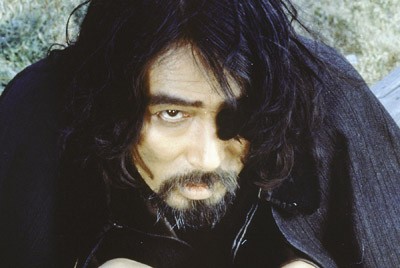Available on Blu-ray from Mon 24 July 2017
Japanese director Seijun Suzuki is best known for his 1967 Yakuza movie Branded To Kill. The film got him fired from the Nikkatsu film studio, but it did go on to influence Quentin Tarantino, Jim Jarmusch and many other directors who like to present violence and controversy on screen. After several years in the wilderness, Suzuki eventually returned in fine form to present the first of his acclaimed Taisho Trilogy of movies.
Zigeunerweisen was released in 1980 and gets it’s title from a gramophone recording by classical musician Pablo de Sarasate. The movie begins with a lingering shot of de Sarasate’s record spinning on a gramophone player and this sets an eerie tone which continues throughout the movie. Zigeunerweisen follows Aochi (Toshiya Fujita) a professor in German who has an encounter with a former colleague called Nakasago (Yoshio Harada). Nakasago is now a nomad and is a rough and dishevelled character, especially compared to the refined and educated Aochi. Their lives begin to intertwine when Aochi helps his former colleague escape from the police. The pair then become infatuated with a Geisha called Koine (Naoko Otani), where the absence of the gramophone recording plays a major role in the bizarre and confusing conclusion to the movie. Zigeunerweisen is a gloriously stylish film, with Taisho era Japan (1912 – 1926) beautifully depicted in bright, vibrant colours.
The year after Suzuki released Zigeunerweisen, he made the second part of his Taisho Trilogy, Kageroza (also known as Heat-Haze Theatre). The movie is set during the same period of time, and sex and relationships again feature. As with its predecessor there is a dream-like quality to the movie, where it can be difficult to tell the difference between fantasy and reality. Yoshio Harada returns, this time to play Wada and proves again that he can depict cantankerous characters who are intent on provoking the lead protagonist. The story is disjointed and involves a playwright Matsuzuki (Yûsaku Matsuda) who meets a woman called Shinako (Michiyo Ookusu). Shinako may or may not be a ghost and director Suzuki takes delight in being ambiguous and vague. He subverts the narrative through a non-linear timeline and asks the viewer to keep up with the dream-like story. Stylish visuals are again present, with the Japanese Kabuki theatre looking lavish and extravagant and this adds to the dramatic mystery that surrounds Kageroza.
Viewers had to wait an entire decade before Suzuki completed his trilogy. Yumeji was released in 1991 and can be seen as a piece of historical fiction that incorporates ghosts, mystery and the supernatural. The movie looks back at the life of poet/painter Takehisa Yumeji (Kenji Sawada) and his ghostly encounter with a widow who is looking for her dead husband. As a painter and poet Yumeji is obsessed with beauty and his compulsion leads him down a path of despair and debauchery. Seijun Suzuki again employs ambiguity to confuse the viewer and to present the frustration of the painter as he deals with his fascination and mania. Yumeji is satisfying conclusion to the trilogy. It is the shortest of the three films and combines the common themes of sex, obsession and the supernatural in a more a succinct and concise manner.
The three movies in the Taisho Trilogy are tied together by their historical setting, their themes and their vibrant and colourful appearance. The three movies compliment one another and underline the cult status of Japanese director Seijun Suzuki.
